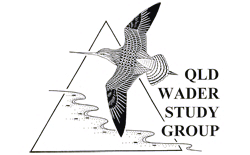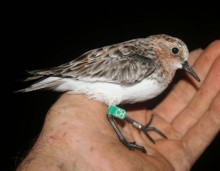What are Leg Flags?
Leg flags are widely used in the study of shorebirds and provide an easily visible means of identifying a bird from a particular location (plain coloured flags) or an individual bird (engraved leg flag) without having to recatch the bird. The flags can be recorded or their codes read using a telescope.
They are made from thin plastic and when formed can be opened and fitted to the leg of a wader and the edges of the flag are glued together. This allows the flag to move freely on the leg without falling off. For many years plain flags have been used to establish migration routes of birds from particular areas. However, increasingly leg flags are engraved with individual codes now which allows individual birds to be identified. This has revolutionised our knowledge of migration as we are now able to record multiple resightings of individuals throughout the year without the need to recatch them to identify them.
Leg flags have been invaluable in identifying the important feeding areas that waders visiting Australia use on their migration. This has provided very real evidence of the vulnerabilities faced by our migratory shorebirds and this information, that many groups are still collecting is being actively used to lobby governments over environmental issues, particularly in the Chinese and Korean staging areas.
What do the different flag colours mean?
Due to the migratory nature of waders the flag codes and combinations used have to be carefully controlled to avoid duplicates appearing in any particular flyway. Flyways are broad corridors within which birds migrate and our birds which visit Australia use the East Asian and Australasian flyway.
Each region involved in banding is issued with a unique flag combination, which is unique to that area. For example, a dark green leg flag on a wader signifies that the bird was caught and flagged in Queensland, Australia, a light blue leg flag however, would have been put on in Japan.
These codes are published on the internet and updated regularly, as new projects start or additional combination start to be used. You can view this list by using the following link, which will take you to the relevant section of the Australasian Wader Study Group’s website. If you see a leg flag of any type in Queensland, please report it to our Leg Flag Coordinator (see the contacts Page and also the page on how to report a leg flag sighting).
For interstate of sightings from abroad, you can use the link below.
Leg Flag Combinations used in the East Asian Australasian Flyway

